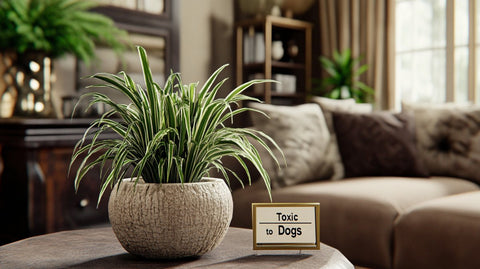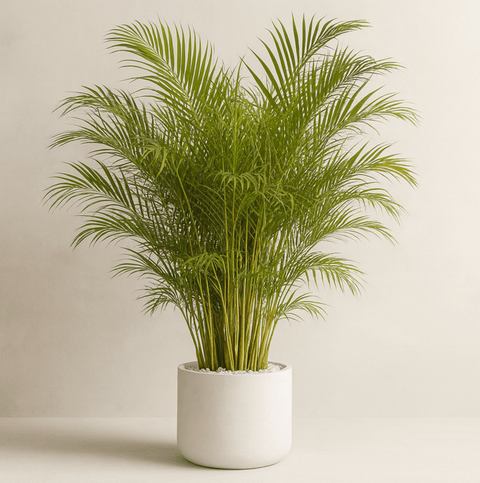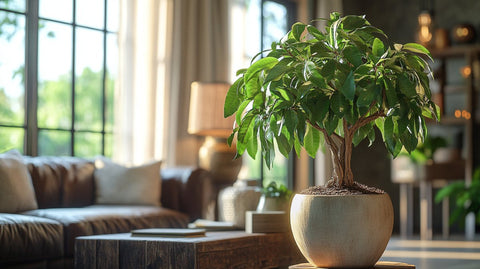Introduction
As more pet owners embrace the concept of indoor green spaces, questions naturally arise about which plants are safe for our four-legged friends. The spider plant, with its striking appearance and low maintenance requirements, is a popular choice for many homes. However, its safety concerning pets, especially dogs, warrants a closer look. This article aims to shed light on whether the much-loved spider plant poses any risk to our canine companions' health.
Understanding Spider Plants

Botanical Overview
The spider plant, scientifically known as Chlorophytum comosum, is a well-loved houseplant revered for its lush, arching leaves and playful baby plantlets. Originating from South Africa, this plant's adaptability and easy-going nature have made it a staple in households around the world. It thrives in a variety of indoor conditions, making it an ideal starter plant for budding plant enthusiasts.
Characteristics and Growth Habit
Spider plants are fast-growing perennials that can easily transition from indoor pots to outdoor gardens. Their leaves are long, thin, and usually variegated, adding a pop of green and cream to any space. Besides their visual appeal, spider plants are praised for their air-purifying qualities, with the ability to remove toxins such as formaldehyde and xylene from the air.
Are Spider Plants Toxic to Dogs?
The Toxicity Debate
The question of whether spider plants are toxic to dogs typically arises due to the plant's subtle hallucinogenic compounds. These compounds, akin to those found in catnip, attract pets, leading them to nibble on the leaves. While cats are known to enjoy the mild high induced by these compounds, dogs may exhibit different reactions.
Potential Effects on Dogs
Although spider plants are generally considered non-toxic to dogs, ingestion can still lead to mild symptoms. These may include gastrointestinal upset, such as vomiting or diarrhea. It is crucial for pet owners to observe any unusual behavior if a dog has ingested plant material. These symptoms are usually transient and resolve on their own, but if they persist, consult a veterinarian.

Precautionary Measures for Pet Owners
Signs Your Dog May Have Ingested Spider Plant
Keep an eye out for signs such as drooling, changes in appetite, or lethargy. If symptoms appear severe or protracted, or if you've noticed considerable foliage missing from your spider plant, contacting a veterinarian would be wise.
Preventive Steps
Placement Strategies
Placing your spider plant out of reach is a practical step. Hanging baskets or high shelves can prevent curious canine mouths from accessing the plant.
Training
Training your dog to avoid houseplants can be beneficial. Commands such as "leave it" can be very effective if consistently reinforced.
Substitute Plants
Consider having alternative plants that are entirely non-toxic and pose no potential harm to pets. For instance, Agapanthus Lily of the Nile Blue and Agave Desmettiana 'Variegata' are excellent ornamental options that add beauty to indoor and outdoor spaces while offering peace of mind to pet owners.
Caring for Spider Plants
Ideal Conditions and Maintenance Tips
Spider plants are undemanding and will thrive in indirect sunlight. They prefer well-drained soil and should be watered sparingly to prevent their roots from sitting in water, which can cause rot. Misting may help maintain humidity, particularly in dry climates.
Propagation Techniques
One of the joys of owning a spider plant is its ease of propagation. Plantlets, or "spiderettes," grow on long stalks and can be potted separately to encourage new growth. This natural multiplication makes spider plants an economical and sustainable choice for plant enthusiasts looking to expand their collection.

Alternative Plant Options for Pet-Friendly Homes
Pet-Safe Trees and Large Plants
For pet owners who may want to steer clear of any potential risks, there are plenty of pet-safe plant options to landscape your home. The Adonidia Palm series is a fantastic starting point. These palms, available as double, single, or triple arrangements, bring a touch of the tropics to your living space, remaining friendly to pets and humans alike.
Low-Risk Indoor Plants
A few low-risk plants that stand out include the Alexander Palm, and the Aglaonema Silver Bay. Their aesthetic charm coupled with their ease of care marks them as desirable choices for any indoor gardener prioritizing pet safety.
Conclusion
The spider plant remains a beloved feature in many homes, with its low maintenance and aesthetic appeal. While it does carry some minor hallucinogenic compounds, its potential effects on dogs are minimal and predominantly non-threatening, categorized by slight gastrointestinal distress. However, pet owners need to stay informed and take necessary precautions to prevent excessive ingestion.
At Plantology, we understand the balance between a thriving indoor garden and the safety of your pets. Explore our wide selection of pet-friendly plants that promise to beautify your home without compromising on pet health. Whether you're introducing the lush elegance of the Adonidia Palm Triple or enjoying the vibrant hues of our Agapanthus selection, there's a perfect choice waiting for your home.
Choose wisely, ensure pet safety, and relish the delightful greenery that only Plantology can provide. Discover our more extensive collection now at Plantology.
Navigating Pet Safety with Indoor Plants

Understanding Plant-Pet Dynamics
The relationship between indoor plants and pets often involves more than just curiosity. Pets, particularly dogs, might find the texture and wobbling leaves of plants akin to toys, while others simply enjoy the environmental enrichment a plant brings into their enclosure. As responsible pet owners, it's imperative to understand these dynamics and anticipate interactions to mitigate adverse outcomes.
Insights from Pet Behavior Specialists
Pet behavior specialists suggest that dogs may chew on plants for various reasons. While boredom is a common factor, nutritional deficiencies might also prompt dogs to consume plant matter. Understanding these motivations not only helps in selecting suitable plant varieties but also encourages addressing the underlying factors, such as enhancing playtime or nutritional supplementation. Consulting with a veterinarian could provide more personalized insights if your pet displays an ongoing fascination with plant foliage.
Is There a Way to Safeguard All Home Plants?
While adopting a blanket approach to keep pets away from all indoor greenery might seem prudent, it may not always be practical. Implementing a combination of strategies can help strike a harmonious balance: selecting non-toxic houseplants, educating pets, and setting physical boundaries can collectively contribute to creating a safe environment. Creating designated 'pet-safe zones' where plants are displayed without pets having unrestricted access might also be beneficial.
Learning from Case Studies
Real-Life Experiences of Pet Owners
To truly appreciate the realities of maintaining a pet-friendly household adorned with plants, we explored the accounts of several pet owners. Maria, a dog owner from Ohio, shared her experience of transitioning to a pet-safe home garden. Initially, her dog Lucy frequently chewed on her plants, but by applying a mixture of non-toxic plant deterrents and relocating her greenery to a dedicated sunroom, she successfully curbed Lucy's interest in houseplants.
Transformative Solutions from Community Forums
An engagement with online plant and pet lover communities also reveals creative solutions. In several cases, using diluted vinegar sprays on plants worked well as natural deterrents without causing foliage damage. Others have built transparent barriers around plant stands using plexiglass—effective at preventing pet access without compromising aesthetics or sunlight exposure.

Enriching Environments for Pets
The Role of Environmental Enrichment
Beyond safeguarding plants, enriching a pet’s environment ensures their behavioral and emotional well-being. Using pet-specific toys, engaging in regular interactive play, and providing puzzle feeders can reduce a pet’s propensity to interact negatively with houseplants. Furthermore, integrating a cozy resting space surrounded by carefully chosen plants can enhance a pet's sense of security and contentment.
Engaging Dogs in Positive Activities
Enrichment doesn't stop with toys alone. Incorporate varied elements such as agility training that uses household items, scent-work games, and even DIY obstacle courses. These activities engage a dog’s natural instincts, leveraging their mental and physical capabilities, keeping them occupied and less likely to seek entertainment from your houseplant displays.
Building an Eco-Friendly Pet Territory
Crafting a pet-friendly garden—complete with sandpits, water features, and safe zones—extends beneficial interactions beyond indoor settings. Introducing this concept to an outdoor space can maximize enrichment opportunities, offering dogs a designated area where their explorative instincts can be freely exercised. Consider using resistant species of grass and native plants that naturally withstand wear and adapt easily to pet activity, ensuring a low-maintenance yet sustainable environment.
Deep Dive into Plant Toxicology
Understanding Toxins Found in Various Houseplants
The study of plant toxicology brings clarity to the risks that common houseplants may pose to pets. While spider plants rank low on the toxicity scale, other popular varieties like lilies, philodendrons, and sago palms present more substantial risks. The toxins present in these plants affect a pet’s cardiovascular, gastrointestinal, or neurological systems, necessitating the importance for pet owners to familiarize themselves with these dangers for better preventive care.
Comprehensive List of Toxic and Non-Toxic Plants
To make informed decisions when adding flora to your living spaces, consider ANSI-certified lists or resources from pet-savvy organizations such as the ASPCA. These resources provide detailed guidelines on the toxicity levels of various plants, aiding in circumventing any unintentional harm to your beloved pets.

Analyzing Symptoms of Plant Toxicity and First-Aid Measures
Recognizing signs of plant toxicity early can drastically improve outcomes for affected pets. Symptoms might range from mild (drooling, vomiting) to severe (seizures, difficulty breathing), depending on the plant ingested. In emergencies, induce vomiting only if advised by a veterinarian, and always strive to keep the ASPCA poison control hotline handy. Implementing rigorous monitoring measures whenever a pet shows signs of distress is paramount, ensuring quick conveyance to veterinary care if symptoms escalate.
Smart Plant Management Techniques
Adopting Smart Plant Placement Strategies
Revisiting plant placement strategies can add layers of protection for plants and pets alike. Incorporate wall planters, ceiling hooks, and hanging gardens that rely on vertical space utilization while minimizing pet access. Alternatively, dedicating a single, pet-proof room for your indoor gardening collection is effective if space allows for controlled isolation.
Automated Plant Care Solutions
Progress in technology offers automated plant management systems—self-watering pots and soil nutrient monitors—that maintain plant health without frequent human intervention. These solutions can be highly beneficial if they help deter a pet's attraction towards hands-on interaction with plants. Many of these systems also allow mobile app integration for monitoring plant hydration levels and optimizing lighting conditions, proving particularly useful for working pet owners managing busy schedules.
Creating a Pet-Focused Plan for Plant Care
Developing a dedicated plant-care routine that harmonizes with pet schedules can establish consistency. Feeding and play routines interspersed with plant care rituals reinforce boundaries, creating a symbiotic relationship between household activities. Over time, pets recognize patterns and adjust their expectations, naturally reducing unsanctioned interactions with plants.

Conclusion and Future Insights
The Future of Pet-Friendly Homes
As our homes increasingly include both pets and plants, adopting mindful living practices paves the way for harmonious coexistence. Emerging trends continue to focus on plant species hybridization, engineered specifically for pet safety, further expanding available options. Meanwhile, multilevel planting systems designed to fit within modern living spaces ensure the seamless fusion of aesthetics, function, and sustainability.
Hope for Continued Research
The ongoing research in botany and veterinary sciences promises a deeper understanding of plant toxicity's intricate effects on pets. This understanding will enhance preventative advice, providing pet owners with actionable insights for informed decision-making. Furthermore, industry collaborations between horticultural experts and pet care specialists could usher in cross-disciplinary solutions, fostering a wave of innovative strategies for pet-inclusive home design.
Living in Harmonious Green Spaces
The timeless allure of plants intertwined with the joyous companionship of pets enriches our lives, offering serenity and love in equal measure. Embrace this enchanting synergy confidently by combining knowledgeable plant selection with attentive pet care practices. Whether starting out or refining existing indoor gardens, the joy of shared spaces ultimately reflects in the vibrant health of both plants and animals, heralding a legacy of green, nurturing households.
Dive into our comprehensive resources at Plantology and discover a myriad of ways to create nurturing sanctuaries that warmly welcome both leaf and paw alike.























Comments (0)
There are no comments for this article. Be the first one to leave a message!